| Poetry Seat |
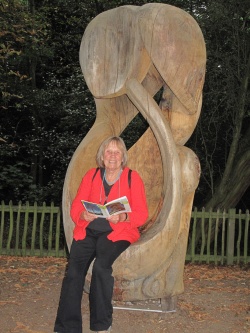 As foretold, though a little later than was expected, the Friends’ latest gift was installed in July by Mtec who are specialist installers of art works. We dealt with their Dave Williams who was helpful and generous in making it all happen. The seat has caught the imagination of a number of passers-by who can be seen photographing each other on it. You can see why another name for it is the “Umbrella Seatâ€. It has been carefully positioned to give a view over the arboretum and meadow which is especially colourful at daffodil, bluebell and campion times. The English oak from which it is carved has been left untreated so that it will weather to a natural grey, melting into the wooded background. It is held in place by a single steel pile, two metres long. This method of fixing was chosen to slip past any tree roots, causing the minimum of disturbance. The chair does rock slightly but we are assured that it is entirely secure and as theft-proof as possible. The sculptor, Martin Pigg, earns his living as a tree surgeon and says it gives him great pleasure to salvage wood from trees he has had to cut down, and give them another lease of life where they will be again appreciated. As foretold, though a little later than was expected, the Friends’ latest gift was installed in July by Mtec who are specialist installers of art works. We dealt with their Dave Williams who was helpful and generous in making it all happen. The seat has caught the imagination of a number of passers-by who can be seen photographing each other on it. You can see why another name for it is the “Umbrella Seatâ€. It has been carefully positioned to give a view over the arboretum and meadow which is especially colourful at daffodil, bluebell and campion times. The English oak from which it is carved has been left untreated so that it will weather to a natural grey, melting into the wooded background. It is held in place by a single steel pile, two metres long. This method of fixing was chosen to slip past any tree roots, causing the minimum of disturbance. The chair does rock slightly but we are assured that it is entirely secure and as theft-proof as possible. The sculptor, Martin Pigg, earns his living as a tree surgeon and says it gives him great pleasure to salvage wood from trees he has had to cut down, and give them another lease of life where they will be again appreciated.The reasoning behind its name was that poetry books would be left there to be read or borrowed by anyone passing. No books have been seen but anyone can bring their own. In our photo Norma Barwis from South London had been enjoying a tour with our editor to look at Holland Park’s uncommon trees – an interest of Norma’s. Naturally they were referring to our tree walk booklet “The Notable Trees of Holland Parkâ€, so used it as a handy prop for the photo. She and Stuart Swann (also from South London and a lover of plants), can be seen using it to identify the Dipelta yunnanensis with its curious seed pods opposite the youth hostel. (If you have lost your copy or never had one, it is only £2 plus postage, obtainable via the order form.)
If you have not yet seen the seat, do go and have a look at it from all sides; you will find it near Lord Holland’s pond.
Rhoddy Wood
Photos by Maggie Quill
[Autumn 2011]
|
|
Bees and Urban Beekeeping |
Having worked in the theatre for a while, ‘surrounded by egos’, Dr Luke Dixon decided that he would like to be around more peaceful creatures, and hit upon bees. At his fascinating talk in the Orangery on 27 October we learnt that bees are mostly quite docile, especially when swarming – surprisingly. He showed us a photo of a swarm which had attached itself to a bollard in the West End of London; it had been cordoned off by the police awaiting the services of Dr Dixon, who came and brushed them off the bollard into a box with his hands. They dropped in quite passively. Bees are thought to have existed for about 130 million years, about the same time as plants. Here we have a somewhat perplexing chicken-and-egg situation: neither bees nor plants can survive without each other since bees are fed by plants which are pollinated by bees; and, incidentally, without bees we humans would starve. We were shown a photo of a cave painting, about 7,000 years old, of a woman up a tree robbing honey from bees, that could be seen flying around her. They would have their nests in holes in trees. Until cane sugar was grown, honey was the only sweetener people could use; it is also full of nutrients: vitamins and beneficial enzymes. The other useful product of bees is beeswax, for a long time the only wax for candles which did not produce a lot of nasty smoke, so it was invaluable for lighting cathedrals and churches. This led to a tradition of beekeeping by monasteries and other ecclesiastical institutions. But there is much earlier evidence of beekeeping which was certainly carrying on by the time of the Pharaohs: a still perfectly edible sample of honey has been found in an ancient burial chamber. The earliest kinds of hives were simple dome-shaped containers called skeps, made of straw or raffia; but in order to get the honey and wax out the bees always had to be killed. Then, about 150 years ago, an American named Lorenzo Langstroth invented hives with rectangular frames onto which the bees were encouraged to build their honeycombs. These could be lifted out safely one by one for taking the honey and wax, and then replaced. From these came the WBC hives, named after William Boughton-Carr who designed them as a series of boxes one above the other; the bottom box is where the queen bee is kept and looked after by the workers: a shield over that section has no holes large enough for her to escape; this ensures that the boxes above (usually two in the traditional British ‘national’ hives), with their rectangular frames, will only be used by the bees to make honey. There is now also a modern type of hive called a beehaus developed by a German, Johannes Paul, especially for amateur urban beekeepers. It is a simple box shape, made of plastic, and available in various colours. The ‘national’ hives are usually made of the naturally oily cedar wood which the bees love and which can last for over a hundred years. Unlike the beehaus these would survive a blow torch that might have to be used to eliminate disease. The queen only leaves the hive for two reasons: to mate or to swarm. After mating she will return to the hive and lay between one and three thousand eggs a day which she fertilises. This is just as well because the female workers, who do all the work, die of exhaustion after six weeks and need replacing. There are about fifty to sixty-thousand bees in a hive at any one time. There would only be about 200 males, the drones, ‘hanging around waiting for sex’. Every now and then they might go out hoping to find a queen to mate with but, if successful, they die. The first three weeks of the females’ lives are spent inside the hive, cleaning, taking out the dead and looking after the queen; the next three weeks they forage for pollen and nectar and make honey from it. When foraging they fly at up to 22 mph; they navigate by the sun and magnetic fields so they cannot forage at night, and stay calmly in the hives, making it a good time to move the bees if this is necessary. As is well known, one bee can communicate the position of useful plants to another by performing a little dance. The bees have two stomachs, one in which they transport the nectar (they carry any pollen, for feeding the young bees, in sacks on their back legs). They bring the nectar into the hive and feed it to another (‘house’) bee that digests it in the other stomach, mixing it with enzymes. Nectar is 80% water and honey 20%, so much has to evaporate. The constant temperature inside the hive of 36ºC helps. Bees that are born at the end of the summer tend to survive for six months through the winter when they have very little to do. The honey is harvested by the keepers at the end of the summer, a wet August yielding a poor one. Some honey has to be left for the bees to eat in the winter, and beekeepers need to check occasionally that they have enough, and supplement it with sugar if necessary. The Western or European honey bee, apis mellifera, is the only bee which can survive a winter. It has now spread, mostly by introduction, to all continents except Antarctica. Originally it is thought to have migrated from Africa. A hive reproduces by splitting itself in half and swarming: the old queen will leave the hive with half the bees who will make a new queen to replace her once they have found a new home. To make a new queen they place about a dozen eggs, which are genetically the same as of any bee, into larger than normal wax cells and feed them on royal jelly; the richness of the enzymes in the latter causes their reproductive systems to kick in. No other bees can reproduce. When the dozen potential queens have developed they sting each other to death until one survives to become the new queen. When bees swarm, the beekeepers have just a few days to catch the swarms and take them back to hives. Before they swarm the bees stuff themselves with food in case they cannot find a new home quickly, which is why they are as docile as a human after a huge Sunday roast: the keepers only need to dump the swarm in front of a hive and, if the queen walks in the bees will all follow. Swarming usually takes place from May to June. It is quite a nuisance for beekeepers, so they check hives not only for disease but for queen cells and get rid of them to prevent swarming. The varroa mite, which has attacked honey bees in Britain in recent years, came from Eastern honey bees, but the good news is that this is now much less of a problem than two years ago.
|
|
Pimm’s in the Park |
On the evening of 21 July the Friends enjoyed a particularly friendly or, one could say, cosy Pimm’s party in the youth hostel garden. This was due to the gently falling rain. The party was saved by Park management as well as youth hostel manager Sally Martyn-Johns who both kindly provided gazebos to shelter the guests. As can be seen in the photo taken by Sally, the Friends were thus encouraged to stand close to each other and make new acquaintances. The successful moorhen family and the large white domestic duck were very much in evidence. [Autumn 2011] |
| Russian Virtuosi Concert |
Â
The first piece was Duo Concertante No.2 in G for violin and viola by Antonio Bartolomeo Bruni (1757 -1821), an Italian violinist and composer who composed some 20 successful opéras comiques and over 200 chamber works, and spent the years 1785 to 1801 in Paris. The Duo started with an allegro con moto in which the melodic line of the violin was at times very like an operatic aria. The second movement, andante, started with a simple melody on the violin which was developed into some half a dozen skilful variations, some on the violin and some on the viola. The second piece was Beethoven’s String Trio in c minor, Op.9, No.3 written in 1798, one of the most impressive of his early works. It follows the four-movement model of the traditional quartet and, most importantly, features the key of c minor which inspired some of his greatest works, including the Piano Sonata No.5, Op.10, No.1 and the fifth symphony. In this trio the journey from c minor to C major is dealt with gently, with the major key coming in at the end of the finale. The piece also displays masterful handling of chamber music texture, and demonstrates Beethoven’s unusual ability to transform simplicity into nobility, the common into the universal. After the interval we started with the allegro of Schubert’s String Trio in B flat major, D471, written in 1816, which was the only movement of the trio completed. It is an example of classical sonata-allegro form and has an engaging freshness and charm. We finished with Mozart’s Flute Quartet in D major, K485, a piece made famous some years ago by James Galway. It was written between 1777 and 1778 for an amateur flautist, Ferdinand Dejean, a wealthy Dutch merchant. Mozart constructed the work as if it were a string quartet with the flute replacing the first violin. Dejean’s requirements seem to have been modest, and Mozart produced a work where the emphasis is on an easy-going and relatively uncomplicated style. However, the second movement, adagio in b minor, is a delightful study in brevity, with the flute producing a melody with similarities to Gluck’s Dance of the Blessed Spirits. It was a memorable evening and we hope that the Russian Virtuosi will come back to entertain us again before too long. George Law
[Summer 2011] |
| Linley Sambourne House |
Â
After only one previous occupier of the house, three generations of the Sambourne family lived there from 1874 to 1980. From the outside the house looks the same as its neighbours except for the two external warding cases. Edward Linley Sambourne (1844-1910) married Marion Herapath whose parents lived in Upper Phillimore Gardens where she had grown up. This was therefore one of the attractions of having their home in Stafford Terrace, the other being the proximity to the homes which artists were now building on the other side of Holland Park. Sambourne, who is famous for being a book illustrator (illustrating the 1885 edition of The Water Babies) and for his cartoons in Punch, was very keen to be taken seriously as an artist. He gained a good reputation as a draughtsman, even among the Holland Park set, but, only working in black and white, he was on the bottom rung of the artistic ladder and was always looking to rise in society. Many artists did indeed visit him, although there is no evidence that Lord Leighton himself did; Sambourne was, however, once invited to Leighton House, after which he noted that the food had been “so-so†and that he had had an upset stomach afterwards, but made no comment on the house or his host. He enjoyed the pursuits of an upper-middle-class gentleman: he liked going hunting and shooting, and befriended businessmen who would invite him. The contents of the house are therefore an interesting mixture reflecting on the one hand the status of a respected member of society and on the other an artist.
The Sambournes had two children, Maud and Maudley (always called Roy). Maud was the perfect daughter, even showing great talent as an illustrator – she had drawings published in Punch before her marriage. In contrast Roy was a constant trouble to his parents. He was difficult to control as a child and therefore sent, at considerable financial sacrifice, to Eton where his school reports always complained that he should try harder. However, he subsequently inherited the house (with his sister) and continued to live in it alone. He regretted the trouble he had given his parents and probably decided, as a kind of atonement, to take great care of the house, preserving it and its contents as much as possible, and not modernising as others were doing. He had it thoroughly photographed in the 1920s.
He had the morning room at the back extended outwards. There was no more than a yard at the back and no view except onto the back of the mews houses, so Sambourne designed stained-glass windows here. On the windows is the coat of arms which Sambourne adopted and modified from a Somerset yeoman named Samborne from whom he liked to presume he was descended. It was used on their stationery, cutlery, door panels and the door of their carriage – which vehicle was one of their great extravagances. Also on the window are the initials L for Linley, M for Marion and S for Sambourne. The joke is that the L seems to be lying on its back with the M on top of it. Does this tell us something about the couple’s relationship? The morning room was mainly his wife’s domain where she would discuss household business with the housekeeper. A huge amount is known about the day-to-day running of the house as all bills, shopping lists, diaries etc. which had been left in the furniture are now kept in the archives. In 2001 the house received a Lottery grant to pay for the cataloguing and storing of these documents. This supporting information is one of the things which makes the house so special. The drawing room is on the floor above the morning room and, unusually, it takes up the entire storey. Again an extension out to the back was made, but this was specifically meant as a working space for Sambourne where he drew all his cartoons until his daughter married and he used her sitting room above as a studio.
When Roy died in 1945 his sister Maud kept the house empty for fifteen years, except for the household staff. She left the house to her three children, one of whom was Anne who first married Ronald Armstrong-Jones (their son was Anthony Armstrong-Jones who became Lord Snowdon); later she married the Earl of Rosse and then bought out her siblings in the 1960s. The Earl and Countess used 18 Stafford Terrace as their London house. They made some changes including the installation of a bathroom and a reversion to William Morris wallpaper. True to family tradition the old paper remained behind heavy furniture. Into the 1970s the Countess was, in vain, trying to get the National Trust and V&A interested in taking on the house. Finally she sold it and most of its contents to the Greater London Council in 1980. Almost at once it was leased to the Victorian Society who ran it as a museum until 2000. Amusingly the Countess would occasionally come back to the house to remove the odd item which she found she needed after all, perhaps for a dinner party: she still thought of the place as her own in some way. Now the house is run by the Royal Borough with Leighton House. As the gathering at this fascinating talk was so select, for perhaps the first time in the Friends’ history it was not necessary to collapse the chairs before Janice Miles arrived with her particularly mouth-watering canapés. Joy Puritz
[Summer 2011]
|
| Poetry Seat |
The maker is Martin Pigg from Norfolk, who has named the seat “oak umbrella chairâ€. He says: “The whole ethos behind my carvings is the Maori Koru which represents life, regeneration and new beginnings. I like to think I give the diseased or wind-blown tree a new life which one hopes will stand for another 200 years. From the start of my tree surgery, I have always collected interesting pieces of wood, hollow stems, burrs, roots etc. which to my mind are sculptures in themselves.â€
The Friends are pleased to give such an intriguing piece to Holland Park.
[Spring 2011] |
| Commonwealth Institute/Design Museum |
The Design Museum, which has plans to occupy the old Commonwealth Institute building, has applied to vary some of the conditions of the original development planning consent. If permitted, the revised hours for the 120-seater restaurant would be until 11.00pm Mondays to Wednesdays and until 11.30pm Thursdays, Fridays and Saturdays. Sundays’ closing time would remain at 10.00pm. In addition, the museum wishes to be allowed to hold corporate hospitality events in the gallery on up to 61 evenings a year; 48 up to 11.00pm, 12 up to midnight and one up to 1.00am for numbers between 350 and 750, and 1000 on the night of the latest closing time. Bearing in mind the need to service the restaurant and these late night events and that there is no on-site parking for guests, local residents may well have concerns about transport issues, parking, noise and possible anti-social behaviour late at night. If you wish to register your comments, you should contact the Executive Director, Planning and Borough Development at the Town Hall, quoting PP/03333, but do it quickly. |
| New Trustees |
At your committee’s September meeting, Carron Batt, Gordon French and Jennie Kettlewell were co-opted as trustees, as proposed and detailed in the autumn newsletter. (Winter2011) |
| Diana Midgley |
Many of our members will have known Diana who was tragically killed in a road accident on 14 March. She was a hugely respected member of the Kensington community, of the RBK&C Conservatives, and an active supporter of St Philip’s Church, the RNLI and the British Legion, not to mention The Friends. We are delighted to acknowledge a generous donation in her memory from The Cowley Charitable Trust, of which she was the benefactor and settlor. We are very grateful. Rest in peace, Diana. |
| New trustees |
We are very fortunate and delighted to have found two prospective new trustees willing to take over two of the more important roles within the organisation, but our success in having attracted them to the work of The Friends is very slightly tinged with regret that the body corporate of our almost1000-strong charity could not produce a single candidate for these positions. Gordon French, an enthusiastic Australian anglophile, has run Gallery 19 in Thackeray Street since 1995, creating a niche market in its promotion of Kensington. Gordon has a strong track record in television development, but he is also a painter and has been painting the buildings of London for 25 years. Who better to organise our annual art exhibition in the Orangery. The plan is for Gordon to take over from Andy Walker, who has managed the exhibition for the past three years with increasing confidence and growing success, and we pay grateful tribute to her for that. It is also excellent that she will be able to hand over to Gordon in an orderly fashion so that he can hit the ground running in preparation for next year’s exhibition. Carron Batt, an American who has lived in London for ten years, also has a strong artistic streak. She has a breadth of experience in advertising and marketing, most recently for Sotheby’s, and for three years in a voluntary capacity for the Art Fund. However, Carron has kindly offered to take on the challenging position of Treasurer from David Jeffreys, combined with the Assistant Treasurer’s role from Nigel Brockmann. David has kindly agreed to induct Carron in the peculiarities of our accountancy software, and between them they will decide on an official handover date. It is, however, good to report that one of our members, Jennie Kettlewell, has also agreed to join the committee. Jennie is as keen on the plants of Holland Park as Rhoddy is and we have wanted another committee member who shares this interest, but we have said that while being interested in plants is an advantage in a trustee, it does not of itself justify a place on the committee. Fortunately, Jennie is an almost-retired management consultant so she has plenty of experience in self-starting and organising and also considerable people management and IT skills. She is well able, and willing, to take on the occasional project for the Friends of the type that has recently been managed by the chairman; recent examples have been the various seats and benches and getting our two new booklets printed. These take a considerable amount of time and energy, which the chairman might be better using in other directions. Also, it might be easier to find a new chairman if he or she knew that they would not be burdened with the day-to-day execution of similar projects. All three have been co-opted as trustees and will stand for re-election at the next AGM. [Autumn 2011] |
| Christmas Cards |
Since the last newsletter came out, our publisher has found a number of old designs of Holland Park hiding in a cupboard; so, after all, we are able to offer mixed packs of 10 large cards of park views which for £6 are great value and always sell well. Additionally we have the smaller cards of the east wing of Holland House (as seen from the youth hostel), and also of the stable yard, at £5.50 for a pack. Large ones of the alcove are £7.50. All designs benefit from a quantity discount of 5% on 100 cards, 10% on 200 and 15% on 300. Overprinting is available on request. The minimum order from us is 10 cards, and from Mountbatten 35. We deliver free if this newsletter arrived without a stamp; otherwise we have to charge £1.25 per pack. Mountbatten deliver free over rather more of London. Many other London views were shown in the brochure sent to you in the last issue of the newsletter which can also be seen on www.mbcards.co.uk, or ask Rhoddy Wood for a new copy. The Friends get an extra discount if you order through us, but if you order directly from Mountbatten, please remember to tick the box saying ‘donate 25% of the net proceeds to the Friends of Holland Park’. |
| Christmas Cards |
We have already had one enquiry for a large number of cards so now is the time to start thinking about them. Listening to comments we have had previously and taking into consideration the economic situation, we are trying an experiment this year which is to produce our new design in a smaller format. It is called ‘East Wing Holland House’ and is the view of the house from the YHA lawn where we so recently drank Pimms. This will be 3 7/8†x 6†compared to 6 x 7 ¾†and 55p each compared to 75p. Overseas postage will be reduced. In the small size we have also reproduced an older and very popular design of the stable yard. In the larger size we have the alcove in the formal garden. Last year the assorted packs of 10 Holland Park cards for £6.00 were very popular so we are repeating them this year and the idea has also been extended to other neighbourhoods so there are also mixed packs of views in RBKC with Battersea. The standard greeting is “With best wishes for Christmas and the New Year†but most designs are also available blank Members will remember that Mountbatten Cards return us 25% of the profit if you fill in our name as your preferred charity. We also get a small extra discount if you order direct from us, using the form enclosed with this newsletter, rather than from Mountbatten using the form at the back of their catalogue. We give free delivery to those who usually receive their newsletters by hand without a stamp but have to charge £1.25 per pack to other people. Mountbatten do hand delivery free over a larger area (see their brochure) and if you want overprinting it is best to go straight to them. The Friends’ minimum order is 10 cards and Mountbatten’s is 35. Sadly, for health reasons, this is the last year that Terry McKivragan will have been able to paint his delightful London scenes for the cards. So if you appreciate them, now is your opportunity to purchase a selection or just go for an extra quantity. Happy Christmas! |
| Rickshaws, Bridges and Teahouses How the Japanese-Style Garden Came to the British Isles Wednesday, 22 February 2012, 7pm in the Orangery. |
The Japanese-style gardens of the British Isles are often portrayed as a minor aberration in garden design or as an insignificant frippery lurking in an Edwardian woodland garden, but the true story is far more fascinating and reveals how these gardens have added to the richness of British garden history and design styles. With Holland Park’s recently re-designed Kyoto Garden still fresh in our minds, we thought members would appreciate a wider view of Japanese-style gardens in the British Isles, and we have been lucky enough to find Dr Jill Raggett to give us an illustrated talk on this subject. Dr Raggett is Reader in Gardens and Designed Landscapes, and Manager of the Centre for the Arts and Design in the Environment at Writtle College, Writtle School of Design, Chelmsford, so is well qualified to enlighten us. We are sure it will be a most interesting evening which will be rounded off as usual by Janice Miles’ delicious canapés. Tickets at £12 can be ordered by calling 0207 602 0304. |
| Dates for your Diary | |
|
All FHP events in the diary are printed in bold. Our bird/nature walks (BNW) will continue to take place on the first Saturday of each month (except August) under the direction of our knowledgeable and informative guide, Ian Thomson. Meet him at Lord Holland’s statue at 9am. The walks are free and everyone is welcome, not just members, so please come and encourage your friends: they might become members too! We recommend you bring binoculars if you can – they make such a difference. Events organised by the Ecology Service of RBK&C are listed as ‘ES’; unless otherwise stated the meeting place is the Ecology Centre (Stable Yard). There is a charge for those marked £. It is advisable to ring the Centre on 020 7938 8186 or e-mail ecology.centre@rbkc.gov.uk to book, for details of any changes or for further events. Sat 3 Dec  BNW |
|
|
Russian Virtuosi |
Members will remember the exciting string music brought to us several times by Natalia Lomeiko, Yuri Zhislin and their friends. Now they have agreed to play for us again – what greater treat could we have on the last evening before the Art Exhibition closes. Details of their programme have not yet been worked out but will be in the next newsletter and, we are assured, will include pieces new to their Holland Park repertoire together with one old favourite. Do put the date in your diary now. Tickets are £15 to include wine so that we can have a party at the end. Meanwhile, with Christmas coming up, how about buying their new Duo CD on NAXOS available in shops as well as online; and if anyone wishes a-signed-by-the-artists CD to be gifted to them or their loved ones for £8.50 incl. postage and packing, contact by phone on 07951577257 or by writing to info@lomeikozhislinduo.com |
|
Reminder and Gift Aid |
We are very grateful to all our members without whom there would be no Friends. It is your impressive numbers (nearly a thousand) that give us influence among the Councillors who make policy and ensure that we are at least listened to if not always agreed with. We hope you will all want to renew. The Friends’ subscription year is the calendar year, so now is the time to pay for 2012. Over half of you give us standing orders, payable on 1 January, and to these we say ‘thank you’, and you need do no more. To the others, please use the order form and make your cheques payable to The Friends of Holland Park. Minimum dues are £12 or £9 for seniors, those 65 or over. Joint members living at the same address pay £20 or £15 if both are seniors. The only exception is that those who have joined since 1 September have their membership valid for 2012. Well over half of you have also signed Gift Aid forms, which means that the Friends can reclaim 28p in the pound from HM Revenue and Customs: this adds up to over £1,000 a year. All queries about membership (e.g. ‘Have I got a standing order?’) to Rhoddy Wood on 020 7602 0304 or |
| Christmas Concert Sunday, 4 December at 7.30pm in the Orangery |
In the last year performance highlights for the choir have included recording the Beethoven Experience with Charles Hazelwood on TV and radio, and Sunday Worship on Radio 4 with the English Chamber Orchestra. In June this year TCC was again invited to perform in Wymondham Abbey, Norfolk, in a very successful fund-raising concert in aid of YMCA Norfolk, conducted by Philip Simms. As always we advise early booking. Tickets are £17 to include wine and canapés, and these can be obtained using the order form , and applications are not restricted to members. [Autumn 2011 |
| Crab Apple Jelly |
Season of mists and mellow fruitfulness and it always gives your secretary especial pleasure to be able to use crab apples grown in the park to make delicious tangy jelly. It is best eaten as an accompaniment to lamb or pork but it is also refreshing on toast. The apples have to be of the wild greeny kind – anything else is too sweet – and there is only one tree of the right bitterness left in the park so its fruit has to be supplemented from elsewhere. We anticipate gathering them in the last week of September so do ring 020 7602 0304 after that to enquire about availability and prices and to arrange collection. Here’s hoping for a bumper crop!                           |
| Bees and Urban Beekeeping Thursday, 27 October at 7pm in the Orangery |
Now that Holland Park has its own bee hives and is producing excellent honey for sale, it is a good time to learn more about these fascinating and complex creatures, but not just because those of us with a sweet tooth enjoy their product. Bees play an absolutely crucial role in the life cycle of plants and trees on which we and other animals rely for food, but they are disappearing. A far greater understanding of them is vital if we ourselves are to survive. Dr Luke Dixon, who keeps bees across London, mostly on rooftops, will give us an illustrated talk. He looks after hives for Kensington Palace, at the Natural History Museum, the London College of Fashion and The 3 Stags Pub in Kennington, amongst other locations. He has co-written a paper on urban beekeeping which has been accepted for presentation at this year’s APIMONDIA, the international beekeeping congress, which this year will be held in Buenos Aires. His book Urban Beekeeping is to be published in 2012. The evening will close with wine and scrumptious canapés provided by Janice Miles. Tickets at £12 each may be ordered on the order form, and applications are not restricted to members. [Summer 2011] |
| Pimm's in the Park | Thursday 21 July 6.00 - 8.00 pm in the Youth Hostel garden
After two very successful parties, this is now firmly back on our annual events calendar after an absence of several years. Thanks to the kindness and generosity of Sally Martyn-Johns, the manager of the youth hostel, we are allowed to hold it in the youth hostel's private garden, adjacent to the east wing of Holland House. Not even the youth hostellers are allowed onto its lawn, so we are especially fortunate! No opera performance is scheduled for this evening, but perhaps we shall be serenaded by a rehearsal. It is also an occasion when we invite a few guests to say ‘thank you' to them for the work they put in to make the Park such a pleasure and delight all the year round. Our parties would be incomplete without Janice Miles's catering and we shall again be able to enjoy her delicious summer canapés. All you have to do is to book your tickets at £12 each on the order form - and pray for good weather! Please note this event is only open to members of The Friends and their guests. |
| Urgent - Help Wanted | The Friends of Holland Park is a community-based charity; it relies on the voluntary input of its trustee committee to function as an effective voice for the conservation and good management of the Park, for the enjoyment of local residents. Now that committee needs greater help and support from the membership if it is to continue as an efficient administration and maintain its activities. Currently we need replacements for our treasurer and art exhibition organiser respectively, but other positions will emerge before very long. With our membership approaching 1,000 it must be possible to find within it competent, confident and, above all, willing people to take up these roles on behalf of The Friends. If you can help The Friends and the Park, please contact the chairman to discuss the positions more fully. If you know anyone who might be interested in supporting the work of The Friends and ensuring that our glorious Park continues to benefit from our efforts, please encourage them to apply. Treasurer The treasurer is responsible for the safe and secure management of The Friends' annual income of some £30,000 and financial assets currently standing at around £80,000. This includes the receipt of annual subscriptions, donations and other revenues; cheque payments for all approved outgoings; banking, investment, licence and insurance arrangements; and preparation of the annual accounts. A former treasurer and chartered accountant assists with the annual accounts, and an assistant treasurer helps with day-to-day banking. The treasurer is also our main channel of communication with the Charity Commission, ensuring compliance both with their requirements and our own Constitution. Accounting or book-keeping experience would of course be desirable, but it is not a prerequisite. However, a head for figures and the ability to use a basic computer accounting program is a must. Art Exhibition Organiser The position involves the receipt of applications for the exhibition and for the advertising poster competition; production of the poster and catalogue; promotion; liaison with stewards and helpers; oversight of the erection of exhibition panels and display of works; on-site receipt of exhibits and return of unsold work; record keeping and accounting. This work is, to quite a large extent, shared by other trustees and Friends. [Summer 2011] |
| Dates for your Diary | All FHP events in the diary are printed in bold. Our bird/nature walks (BNW) will continue to take place on the first Saturday of each month (except August) under the direction of our knowledgeable and informative guide, Ian Thomson. Meet him at Lord Holland’s statue at 9am. The walks are free and everyone is welcome, not just Members, so please come and encourage your friends: they might become Members too! We recommend you bring binoculars if you can – they make such a difference.
At the time or writing, events organised by the Ecology Service of RBK&C have not yet been advertised. These will appear on their website at www.rbkc.gov.uk/ecology. The telephone number of the Ecology Centre (in the Stable Yard) is 020 7938 8186 and their e-mail address is ecology.centre@rbkc.gov.uk. Sat 5 Mar BNW [Spring 2011]
|
Subscription Reminder and Standing Orders |
Thank you to all those who have renewed their subscriptions for 2011. The subscription year starts on 1 January when all renewals were due except from those members who have joined since September 2010. Currently we have about 750 members paid up for 2011, including nearly 600 who paid by standing order on 1 January. That leaves about 200 who have not yet paid and if you have not done so, please do so NOW! And if you fill in the Standing Order Form, you never need to remember again.All queries about membership (e.g. “Have I got a standing order?â€) to Rhoddy Wood on 020 7602 0304 or rhoddy.wood@virgin.net [Spring 2011]
|
| Treasurer to The Friends | A vacancy among The Friends’ voluntary trustees will emerge over the next few months when our present treasurer retires. This is an important role and we are keen to find a suitable replacement quickly to enable a period of shadowing the present incumbent, followed by a smooth handover.
The treasurer is responsible for the safe and secure management of The Friends’ annual income of some £30k and financial assets currently standing at around £80k. This includes the receipt of annual subscriptions, donations, and other revenues; cheque payments for all approved outgoings; banking, investment, licence and insurance arrangements, and preparation of the annual accounts. A former treasurer and chartered accountant assists with the annual accounts and an assistant treasurer helps with day-to-day banking. The treasurer is also our main channel of communication with the Charity Commission, ensuring compliance both with their requirements and our own Constitution. Accounting or book-keeping experience would of course be desirable, but it is not a pre-requisite. However, a head for figures and the ability to learn a basic computer accounting program is a must. If you feel this is something you could do, and you would like to help The Friends and the Park in such a tangible and recognised role, please contact the chairman or the treasurer to discuss the position more fully. If it is not for you, please consider if any of your friends might be interested in supporting the work of The Friends and ensuring that our glorious Park may continue to benefit from our efforts. [Spring 2011]
|
| Russian Virtuosi Concert Saturday, 2 April at 7.30pm in the Orangery |
What could be pleasanter than rounding off our 2011 Art Exhibition with music. We are delighted that Russian Virtuosi Natalia Lomeiko (violin) and Yuri Zhislin (viola), already well known to us, are performing for us again, this time joined by Zoya Vyazovska (flute) and Richard Harwood (cello). The programme will consist of Schubert’s String Trio in B flat, Beethoven’s String Trio in c minor, Bruni’s Duo for Violin and Viola, and Mozart’s Flute Quartet No.1 in D.
[Spring 2011]
|
|
 Art Exhibition 2011The Art Exhibition in the Orangery will open to the public from Saturday afternoon 26 March until Sunday 3 April. It is a really interesting and varied display and the setting is exceptionally beautiful, so do come along and bring your friends. We hope to give pleasure to everyone but also to sell as many works as possible and to encourage visitors to join The Friends of Holland Park. All artists who enter the exhibition should note the timetable below as all the dates are very important. The deadline for receipt of the exhibits details form is Wednesday 2 March to make sure that works are listed in the catalogue. If these are late it makes it harder for us to organise and harder for visitors to see all the details. Full information on both the main exhibition and the minimarket can be seen at The Friends’ website www.thefriendsofhollandpark.org. If you would like to become a Friend or register for the exhibition you should contact Mrs Rhoddy Wood, 21 Kenton Court, 356 Kensington High Street, W14 8NN, rhoddy.wood@virgin.net. For other information contact Mrs Andy Walker, 4 Iverna Gardens, W8 6TN, a.m.walker@virgin.net. As usual a prize of £150 for artistic excellence will be awarded, together with two prizes of £75 each, one for the work which best expresses the essential spirit and quality of Holland Park, and one for a three-dimensional work. We are very pleased that Isabel Langtry has agreed to judge the entries, and the prize-winners will be announced at the Private View of the exhibition on Monday evening, 28 March. Art Exhibition TimetableWed 2 March Deadline for details forms for all exhibits to reach us, to allow for listing in the catalogue. The exhibition is open to the public free of charge on Saturday 26 March from 1.00-6.30pm and from Sunday 27 March to Sunday 3 April from 10.30am – 6.30pm. Artists and buyers collect their works after the exhibition on [Spring 2011]
|
|

.jpg)
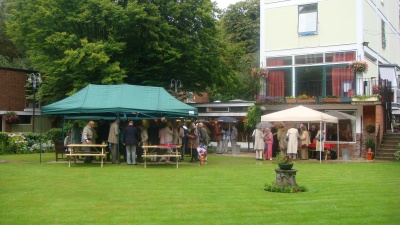
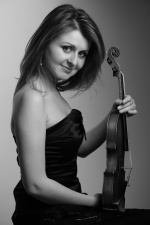 Those who did not attend on 2 April missed a fascinating evening of musical performance of the highest quality with a varied programme. Our old friends Natalia Lomeiko (violin) and Yuri Zhislin (viola) were supplemented by another Russian, Zoya Vyazovska (flute), and Richard Harwood (cello), who is British.
Those who did not attend on 2 April missed a fascinating evening of musical performance of the highest quality with a varied programme. Our old friends Natalia Lomeiko (violin) and Yuri Zhislin (viola) were supplemented by another Russian, Zoya Vyazovska (flute), and Richard Harwood (cello), who is British.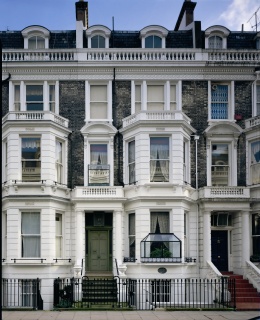 There was a select gathering of Friends in the Orangery on the evening of 10 February to greet Daniel Robbins, Senior Curator of both Leighton House and of Linley Sambourne House. On this occasion he was telling us about the history of Linley Sambourne House, a Victorian terrace house at 18 Stafford Terrace at the southern end of the Phillimore Estate. Open between September and June at certain times on Wednesdays and weekends (and other days by arrangement), the public are taken on guided tours (on weekend afternoons by actors) and shown the Victorian home in which almost all the furnishings and fittings are unchanged since the late 19th century. Mr Robbins said that while Leighton House was the “hidden gem†of the borough, “Lily†Sambourne House was the “hidden, hidden gemâ€.
There was a select gathering of Friends in the Orangery on the evening of 10 February to greet Daniel Robbins, Senior Curator of both Leighton House and of Linley Sambourne House. On this occasion he was telling us about the history of Linley Sambourne House, a Victorian terrace house at 18 Stafford Terrace at the southern end of the Phillimore Estate. Open between September and June at certain times on Wednesdays and weekends (and other days by arrangement), the public are taken on guided tours (on weekend afternoons by actors) and shown the Victorian home in which almost all the furnishings and fittings are unchanged since the late 19th century. Mr Robbins said that while Leighton House was the “hidden gem†of the borough, “Lily†Sambourne House was the “hidden, hidden gemâ€.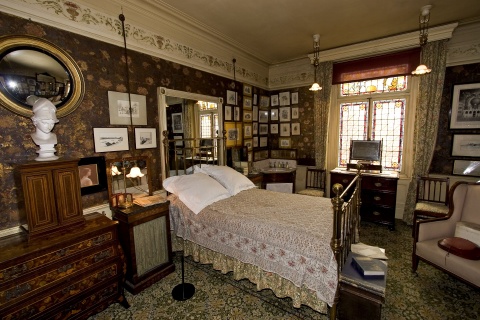 Sambourne was the son of an importer of furs. He trained as a draughtsman in an engineering firm. After submitting drawings to the editor of Punch he was taken on by the magazine and was eventually, from 1901, their chief cartoonist by which time he was quite a celebrity. Having to produce a weekly cartoon was quite a bind, of course. The routine was that there would be a weekly dinner at which the subject matter of the next cartoon was decided upon; then Sambourne had to produce it in time for a boy to collect it from his home one morning three days later. He became increasingly interested in doing photography, and found that it made drawing quicker and more accurate since he could trace from the photographs. He had a so-called “spy†camera with which he could photograph people without them knowing; he also used models, including his own family and himself. We were even shown a photo of their housemaid asleep in bed. He cut out pictures from magazines to use. These, and his photos, were filed away in a folder which he called “From a Welshman to a weaselâ€. His glass-plate negatives were all preserved on high shelves in his studio. Because of his work schedule he was not able to go away for long periods, but one of his favourite activities was to set off for France in the morning, have a meal once he got there and return on the same day. He tended to eat huge amounts of food every evening washed down by large quantities of champagne, often leaving him feeling “seedy and bilious†the next day; his cure for that was to go riding every morning.
Sambourne was the son of an importer of furs. He trained as a draughtsman in an engineering firm. After submitting drawings to the editor of Punch he was taken on by the magazine and was eventually, from 1901, their chief cartoonist by which time he was quite a celebrity. Having to produce a weekly cartoon was quite a bind, of course. The routine was that there would be a weekly dinner at which the subject matter of the next cartoon was decided upon; then Sambourne had to produce it in time for a boy to collect it from his home one morning three days later. He became increasingly interested in doing photography, and found that it made drawing quicker and more accurate since he could trace from the photographs. He had a so-called “spy†camera with which he could photograph people without them knowing; he also used models, including his own family and himself. We were even shown a photo of their housemaid asleep in bed. He cut out pictures from magazines to use. These, and his photos, were filed away in a folder which he called “From a Welshman to a weaselâ€. His glass-plate negatives were all preserved on high shelves in his studio. Because of his work schedule he was not able to go away for long periods, but one of his favourite activities was to set off for France in the morning, have a meal once he got there and return on the same day. He tended to eat huge amounts of food every evening washed down by large quantities of champagne, often leaving him feeling “seedy and bilious†the next day; his cure for that was to go riding every morning.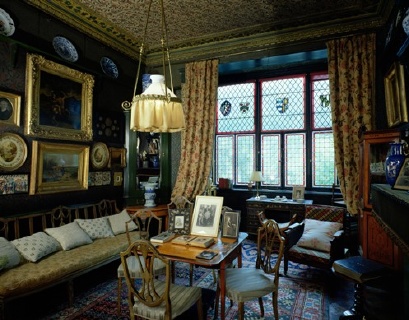 The amount of furniture was almost excessive. Sambourne himself was the driving force behind the furnishing of the house rather than his wife, who wrote in her diary in despair about the fourteen chairs in their bedroom alone. The inventory of 1877 shows that most of what can now be seen was already there. He had the whole house papered in William Morris designs – a self-consciously artistic thing to do. Sambourne liked to give the impression that he only acquired the very best, but a lot of it he found at auctions and house clearances. There is very little of significance, therefore, but it was how he arranged it as artistically as possible which was important.
The amount of furniture was almost excessive. Sambourne himself was the driving force behind the furnishing of the house rather than his wife, who wrote in her diary in despair about the fourteen chairs in their bedroom alone. The inventory of 1877 shows that most of what can now be seen was already there. He had the whole house papered in William Morris designs – a self-consciously artistic thing to do. Sambourne liked to give the impression that he only acquired the very best, but a lot of it he found at auctions and house clearances. There is very little of significance, therefore, but it was how he arranged it as artistically as possible which was important.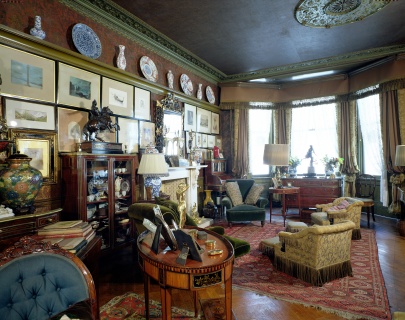 The Sambournes were always short of money so they would sometimes cut corners: when they had the William Morris wallpapers replaced with embossed and gilded paper, which was not cheap either, they only replaced the paper on exposed parts of the walls, not those behind furniture or pictures, which makes for a bizarre sight when these are removed. The fact that their many framed items hanging on the staircase and in the rooms were mostly photos or reproductions shows that their funds were limited.
The Sambournes were always short of money so they would sometimes cut corners: when they had the William Morris wallpapers replaced with embossed and gilded paper, which was not cheap either, they only replaced the paper on exposed parts of the walls, not those behind furniture or pictures, which makes for a bizarre sight when these are removed. The fact that their many framed items hanging on the staircase and in the rooms were mostly photos or reproductions shows that their funds were limited.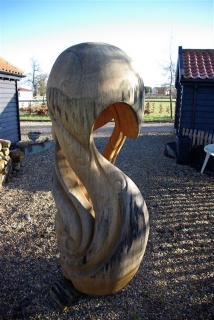 Keep an eye out for this unusual chair, carved from English oak, following the natural grain and burrs of the wood and already silvering with exposure to the elements. Your secretary first saw it at Chelsea, surrounded by roses on an award-winning stand. It will reach the Park next spring and will probably be placed facing the Arboretum (last year’s pig enclosure). This is a peaceful area and, we judged, appropriate to sit on and read poetry. If you have not brought your own, you will find changing volumes to explore.
Keep an eye out for this unusual chair, carved from English oak, following the natural grain and burrs of the wood and already silvering with exposure to the elements. Your secretary first saw it at Chelsea, surrounded by roses on an award-winning stand. It will reach the Park next spring and will probably be placed facing the Arboretum (last year’s pig enclosure). This is a peaceful area and, we judged, appropriate to sit on and read poetry. If you have not brought your own, you will find changing volumes to explore.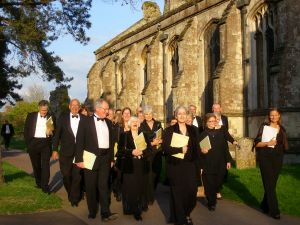 The Tallis Chamber Choir (TCC) and their conductor, Philip Simms, are delighted to be invited back by the Friends to perform our Christmas Concert in the Orangery for the twelfth year in succession. This is our most popular annual event, so we hope you will put the date firmly in your diary.
The Tallis Chamber Choir (TCC) and their conductor, Philip Simms, are delighted to be invited back by the Friends to perform our Christmas Concert in the Orangery for the twelfth year in succession. This is our most popular annual event, so we hope you will put the date firmly in your diary.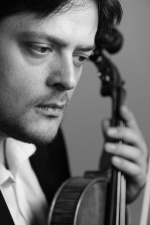 Records, Fone and Naxos. Yuri Zhislin, also a Professor at the Royal College, was described by the Strad magazine as “a virtuoso with a lyrical talent and truly Romantic temperamentâ€. He is a winner of the BBC Radio 3 and Dvarionas International Violin Competitions. In 2004 he established his own chamber orchestra, Russian Virtuosi of Europe, and he is much in demand as violinist and violist in concerts and festivals around the world. He has recorded for Somm and Naxos. Zoya
Records, Fone and Naxos. Yuri Zhislin, also a Professor at the Royal College, was described by the Strad magazine as “a virtuoso with a lyrical talent and truly Romantic temperamentâ€. He is a winner of the BBC Radio 3 and Dvarionas International Violin Competitions. In 2004 he established his own chamber orchestra, Russian Virtuosi of Europe, and he is much in demand as violinist and violist in concerts and festivals around the world. He has recorded for Somm and Naxos. Zoya 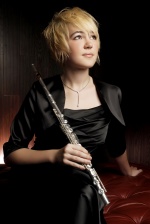 Vyazovska, having studied piano, harp, flute and violin in Moscow is now in her second year at the Royal Academy of Music, studying flute with William Bennett. Since 2001 she has played as a soloist with several orchestras in the main Moscow concert halls. In 2010 she performed with the Odense Symphony Orchestra, won 2nd prize and Special Prize for Interpretation in the Carl Nielsen International Flute Competition. Richard Harwood, the only one of our artists who is not Russian born, made his concerto debut at the age of ten. He has performed concerti and recitals in major venues such as the Royal Albert Hall, the South Bank, the Wigmore Hall and the Musikverein (Vienna). He has been soloist with several major orchestras here and abroad. He has given many radio broadcasts for the BBC, in France and in New Zealand, and has recorded for EMI, among others. He was the first British cellist to be awarded the title Bachpreisträger at the 2004 International Johann Sebastian Bach Competition in Leipzig.
Vyazovska, having studied piano, harp, flute and violin in Moscow is now in her second year at the Royal Academy of Music, studying flute with William Bennett. Since 2001 she has played as a soloist with several orchestras in the main Moscow concert halls. In 2010 she performed with the Odense Symphony Orchestra, won 2nd prize and Special Prize for Interpretation in the Carl Nielsen International Flute Competition. Richard Harwood, the only one of our artists who is not Russian born, made his concerto debut at the age of ten. He has performed concerti and recitals in major venues such as the Royal Albert Hall, the South Bank, the Wigmore Hall and the Musikverein (Vienna). He has been soloist with several major orchestras here and abroad. He has given many radio broadcasts for the BBC, in France and in New Zealand, and has recorded for EMI, among others. He was the first British cellist to be awarded the title Bachpreisträger at the 2004 International Johann Sebastian Bach Competition in Leipzig.